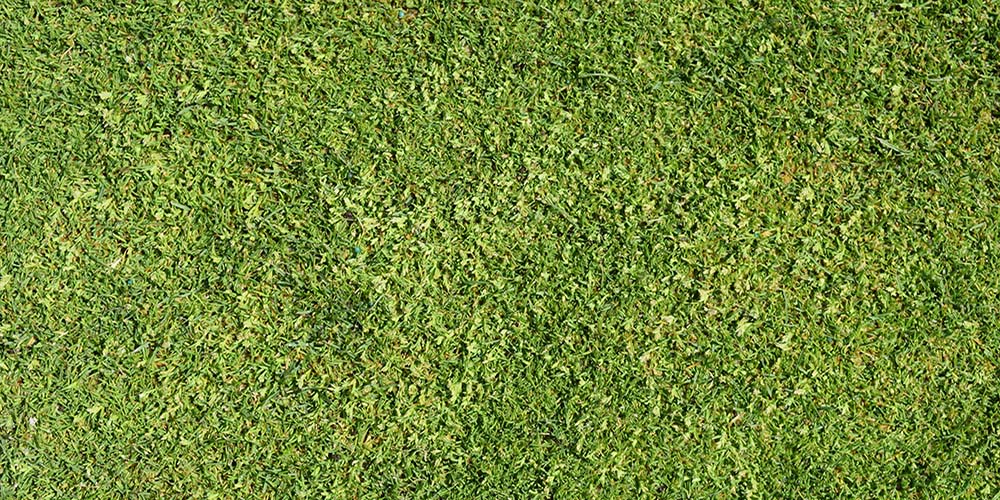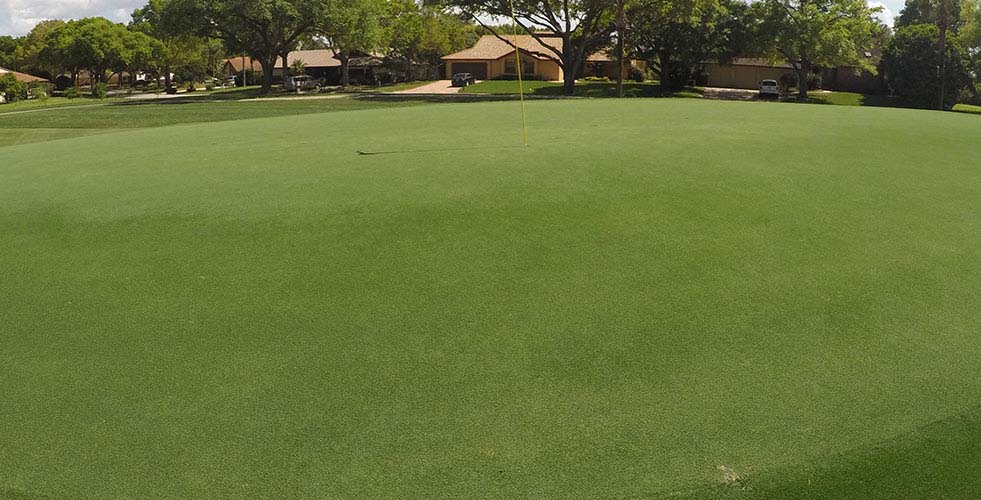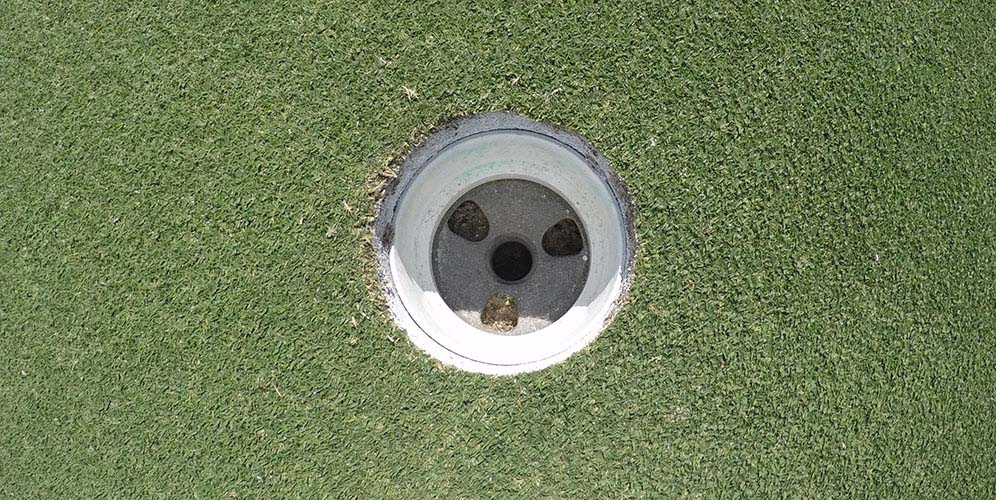All putting surfaces are not created equal. The type of grass on the green changes from course to course because each course has their own budget and climate considerations. When people talk about golf courses, they always want to hear how the greens are. If a course is not in good condition but the greens are good, the average golfer is happy. But most golfers don't pay much attention to the type of grass on the greens; not realizing how different types of grass will affect their ball. From bermuda to bent, we are going to cover all the different types of grass on the greens and how to putt your best on them.
Bent grass
Bent grass can primarily be found in the midwest. It is considered by many to be the cat's meow. It grows best in cooler climates but can't withstand heat like some other grasses. Unlike bermuda, bent is a finer grass that lays down on the green. Bent greens are typically perfect in the spring and fall and don't have any grain on them. The blades of grass aren't strong enough to have a significant effect on the break of your putts. It provides a very true roll and, when maintained correctly, bent is hard to beat. Keep these keys in mind next time you're putting on bent grass.
Focus on Your Line - You will probably not be fooled by the speed of putts on bent grass greens. Everything you need to read the green is based in the slopes that are very easy to see with the naked eye. The ball rolls so true on well-maintained bent grass that there is nothing to bump it back on line if it gets off track. It's like putting on your basement carpet. Focus on starting the ball on your intended target line above all else.
Soft Grip Pressure - If your normal putting grip pressure is a 6 on a scale of 1-10, reduce that grip pressure to about a 4. Bent greens are often fast and require soft hands to allow you to make a smooth stroke.
Smooth Stroke - The smoother the stroke the better. Nothing should be rushed or hurried on bent grass. Try counting in your head to smooth out your tempo if you're having trouble. Count "one, two" or "one, two, three" during your stroke. Be sure to say each number slowly. The slower you say the numbers the smoother your stroke will be.
Poa Annua

Typically found on the west coast of the United States, Poa is a grass that grows very quickly throughout the day. Poa is fantastic to putt on in the morning. It is smooth and true and there is absolutely no grain. As the day goes on, though, Poa grows tiny little flower tops that become visible. These flower tops may look insignificant, but they totally change how the greens roll. It's like putting on gravel when the white flower tops are blooming. The ball begins to noticeably bounce and can be knocked off line often. This makes putting on Poa in the afternoon extremely challenging, even for the best players in the world. Here is the strategy to use on Poa:
Set Up to Your ball for the best read - Poa is tricky to read. Often times it will look like a putt is going to go one way from one side of the hole and it will look like it's going the other way when you look from the other side. Don't let this confuse you. Instead of walking to the other side of the hole, stand over your putt for a second. If you stand over the ball like you're getting ready to putt it you will be able to feel the break in your feet. This will always be your best read and lead to the least amount of indecision.
Die your putts - You should not get aggressive on Poa Annua. Three and four footers are much more difficult because of the bumpiness of this surface. Your goal should be to have your putt stop within a foot of the hole if it misses.
Play maximum break - Bumps magnify break. Play the most break you can see and feel.
Bermuda

Bermuda is the most common grass on courses throughout the United States. It can be great at times and your worst enemy at others because it grows like a weed. Thick blades of coarse grass that almost always grow towards the setting sun. The grain is VERY strong on Bermuda. Grain is something that absolutely must be understood before you even attempt to putt on bermuda greens. Always determine which way the grain is growing before you putt so you have a better idea of what the ball will be doing by the hole. There are typically 3 ways to read the grain:
Notice the colors - Bermuda grass talks to you with its colors. Look at the green from one side and it will look like it is a completely different color than if you look at it from the other side. One direction will look dark, and the other will look shiny. When the green looks very shiny, the grains of grass are growing away from you. This will make a flat putt much faster than it looks and downhillers will become lightning fast. Conversely, when the green looks to be much darker than normal, the grain is growing towards you. Putts into the grain will be very slow. Many times they will be shockingly slow. Make sure you know whether you are putting down grain or into the grain to accurately gauge speed.
Look at the hole - Part of the hole will look like it is damaged. It will be brown or have grass growing over it while the other parts of the hole will look pristine. The grain always grows towards the damaged side of the hole. If the hole is shaggy on the right side and looks perfect on the left, the grain is going to push your ball to the right. Determining which way the grain is growing by the hole will help you especially on the 4-6 foot putts.

Look to the setting sun - Sometimes, you just can't see the grain even when you're looking. Remember that Bermuda grass most often grows towards the setting sun. Picture the sun pulling the grass with it as it moves through the sky. Use this as a guide if you're indecisive.
Putting down grain on bermuda isn't much different than putting on bent grass. Putts will be fast and roll true. A smooth stroke with light grip pressure is still advised. However, putting into the grain is a totally different animal. Significant adjustments must be made.
Firm grip pressure - Adjust your grip pressure to a bit firmer than normal (without strangling the putter). It should feel like your grip pressure is about a 7 on a scale of 1-10.
More shaft lean - At address, the handle of your putter should be about an inch closer to the target than normal. This will promote a tighter roll on the ball allowing it to barrel through the thick grain.
Accelerate - Go ahead and hit it. Deceleration is your worst enemy when putting into the grain. Make sure you're making an aggressive stroke through the ball with plenty of acceleration.
Paspalum
Paspalum is very unique. It can grow and absorb salt water from the ocean. This grass is becoming more popular among superintendents on the coasts because the maintance required for upkeep is far less than traditional grasses. The grass itself is usually a finer grass that almost looks like it is standing up. It typically rolls very true. The only notable difference on Paspalum greens is that they don't break as much as it looks like they will. You can usually divide the break you see in half and go ahead and be aggressive.